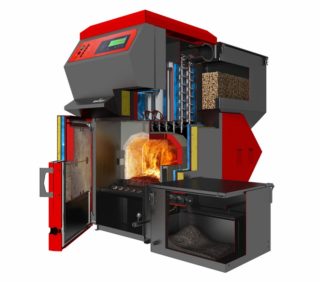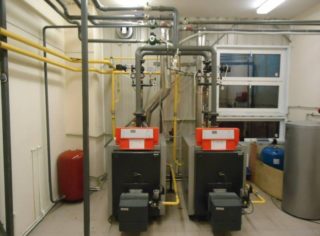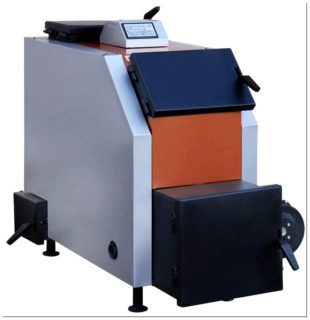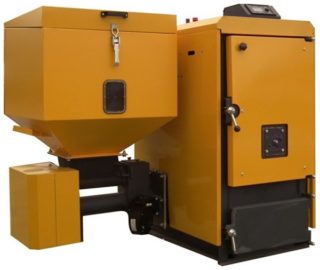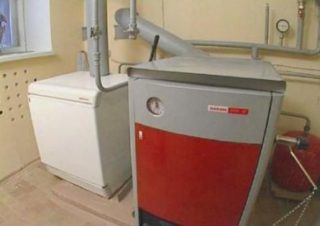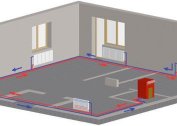There are different types of heating devices used in private homes, but increasingly, users prefer to purchase a combined boiler for heating a private house. It is an apparatus that is capable of simultaneously operating on several types of fuel: electricity and gas, solid fuel or diesel.
Principles of operation of a combined boiler
Combined boilers are usually equipped with two furnaces designed for different fuels. The principle of operation depends on the type of product. For the device on electricity and solid fuel, the first option is an auxiliary one. It is characterized by the presence of a heating element in the heat exchanger, which works when connected to a power network. If there is an interruption in the supply of electricity, the device is transferred to firewood. However, additional equipment is not required.
Some types of boilers are not dependent on the mains, as they operate on gas and liquid or solid fuel. When switching, changing the settings or installing additional burners is not required, since they are already included in the design. Most models are equipped with a firebox and a union nut, which switches between fuel supply lines.
Advantages and disadvantages
An electric wood boiler, as well as other device options, provide uninterrupted supply of heat to a private house. The equipment allows you to use a certain type of fuel at the most convenient time in order to save money. The following advantages are distinguished:
- lack of need for installation of backup heating equipment;
- autonomy of work;
- universality: any type of fuel can be both primary and secondary;
- high level of efficiency;
- profitability;
- simplicity and ease of use - most products are equipped with automation;
- service life: up to 25 years;
- the ability to connect a warm floor system.
The combined device also has disadvantages: the high cost of equipment, the need to organize a place for storing liquid or solid fuels, and expensive maintenance. The devices weigh a lot. To carry out the setup requires the services of a professional.
Fuel Combination Options
Combined heater operates on gas and electricity, wood and gas, wood and electricity, or on three types of fuel. Each type of boiler has its own advantages and features.
Gas and electricity
The gas-electric apparatus is installed if the house needs to be provided with heat and hot water. In such a system, it is allowed to mount several circuits. The device is small, consumes a small amount of energy. Electricity in this case is an auxiliary fuel option.
Since there is no separate combustion chamber in the apparatus (the heater is installed in the heat exchanger), the total cost of the boiler is low. However, electricity cannot be called cheap energy, therefore, in regions where gasification is poorly developed, it is better to provide other options for heating devices.
Gas and firewood
Combined gas boilers where a gas burner and a wood firebox are combined are more economical. Devices of this type are heavy and are installed only on the floor, since steel and cast iron are used for the manufacture of furnaces.The market offers two- and single-circuit models. The first type provides the house with heat and hot water.
Such a boiler is equipped with one common or two separate furnaces. The second option provides for the location of the gas burner in the lower part of the structure, and the chimney in the upper. Both furnaces are heated at the same time. To eliminate the products of combustion, there is a special pan, which greatly facilitates the cleaning process. But it is installed only if solid fuel is used. The product has the following positive qualities:
- ease of maintenance and operation;
- the ability to connect 2 heating circuits;
- independence from the electric network;
- high efficiency (up to 90%).
A gas-wood device needs additional foundation equipment during installation. For storage of firewood or pellets, a separate room is required. Also need a constant reloading of firewood.
Electricity and firewood
Combined boilers for heating a private house “firewood-electricity” is the safest option. The main fuel in this case is wood or pellets. Electricity is needed only to maintain the air temperature in the room at the same level. The device is convenient to use at night, as you do not have to throw firewood into the furnace every 4 hours.
The electric wood boiler is equipped with an automation system that controls its operation mode as well as power. It is not necessary to switch the fuel types manually. The unit has a high level of security. For an electric solid fuel boiler, such advantages are characteristic: low cost of equipment, the ability to automatically configure, high efficiency.
Multi-fuel heating boilers
A multi-fuel version of heating devices is good in that it allows you to use 3 or more types of fuel: gas, electricity, pellets, firewood. It is equipped with several combustion chambers. Additionally, an electric heater can be provided in the design, which is localized in the heat exchanger.
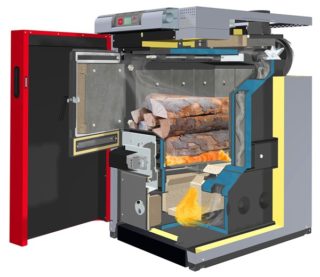
Since the pellet burner is easily removable, it is possible to use diesel fuel or gas. To install such a unit, the following conditions must be met:
- Power supply without interruption. Only in this case can a pellet, gas or diesel burner work.
- The presence of an organized supply of selected fuel materials.
- Providing a separate room for the storage of materials.
Before installing combined boilers “solid fuel-electricity-gas”, it is necessary to calculate the feasibility of their use. The cost of such a device is high and not available to everyone. Chimney equipment is required, as well as providing a minimum draft factor for each fuel material used.
Criterias of choice
To know which combined unit to choose for heating a private house, you need to take into account the technical parameters of the device, the dimensions and number of storeys of the structure, the required power.
- Power. On 10 sq.m. The area requires 1-1.5 kW of thermal energy. For a double-circuit boiler, this indicator increases to 1.5-2 kW by the same area. If you exceed this value, the device will idle. This speeds up the wear of components, increases fuel consumption and the cost of heating in general. Work in this mode contributes to the formation of condensate inside the device.
- Fuel availability. Not all regions have the opportunity to connect to the gas pipeline or purchase firewood.
- The size of the house.
- The need to organize the supply of hot water. If a boiler is already present in the house, there is no need for a double-circuit boiler.
- Unit cost.It depends on the power, additional functions, the reputation of the manufacturer.
- Dimensions and material of the manufacture of the device. The dimensions of the boiler are important if it will be placed in a small room. Of the materials, the best option is steel or cast iron. Such products are characterized by a long service life.
- Availability and availability of components.
- Weight. For some devices, it is necessary to build an additional foundation.
- Installation requirements. Most gas or electric heaters require special approval from the appropriate installation services.
- Convenience in operation. Well, if the device is equipped with automation and additional levels of security.
You can install the product in the kitchen, but it is better to allocate a separate room for it. You also need to pay attention to the complexity of setting up and connecting the device.
Installation of combined boilers
Multi-fuel devices are mounted according to a previously developed project, and also after obtaining permission from special services. Installation requirements are:
- The room. The unit may only be installed on a concrete base, which must be reinforced. The walls of the room should be built of non-combustible materials. In the boiler room, it is important to ensure dryness. The room should be well ventilated. The minimum distance from the boiler to the walls is 30 cm. The boiler room must comply with fire safety standards: a sheet of metal is laid in front of the firebox, it is forbidden to store flammable substances in the room.
- Chimney. The internal diameter of the structure is equal to the pipe of the heating device. To ensure a normal draft level, the chimney must rise above the ridge of the roof. It should not be damaged. To avoid condensation inside the chimney, it must be insulated. The construction requires periodic cleaning.
- Electricity grid. Must withstand the load of the boiler. If the power of the heating element is more than 6 kW, the optimal voltage in the network is 380 V. The electrical equipment must in no way be in contact with water. The temperature in the boiler room must remain between 0 and +45 degrees.
The stove in the house is a long-obsolete building, instead of which multi-fuel boilers are successfully used. They require proper installation and compliance with operating rules, but provide uninterrupted heating in any conditions.
